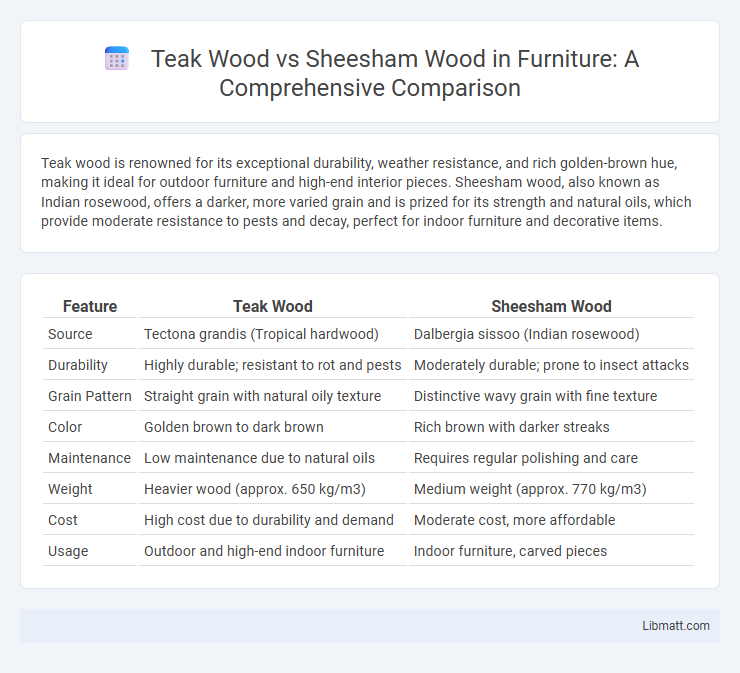Teak wood is renowned for its exceptional durability, weather resistance, and rich golden-brown hue, making it ideal for outdoor furniture and high-end interior pieces. Sheesham wood, also known as Indian rosewood, offers a darker, more varied grain and is prized for its strength and natural oils, which provide moderate resistance to pests and decay, perfect for indoor furniture and decorative items.
Table of Comparison
| Feature | Teak Wood | Sheesham Wood |
|---|---|---|
| Source | Tectona grandis (Tropical hardwood) | Dalbergia sissoo (Indian rosewood) |
| Durability | Highly durable; resistant to rot and pests | Moderately durable; prone to insect attacks |
| Grain Pattern | Straight grain with natural oily texture | Distinctive wavy grain with fine texture |
| Color | Golden brown to dark brown | Rich brown with darker streaks |
| Maintenance | Low maintenance due to natural oils | Requires regular polishing and care |
| Weight | Heavier wood (approx. 650 kg/m3) | Medium weight (approx. 770 kg/m3) |
| Cost | High cost due to durability and demand | Moderate cost, more affordable |
| Usage | Outdoor and high-end indoor furniture | Indoor furniture, carved pieces |
Introduction to Teak Wood and Sheesham Wood
Teak wood, known for its high oil content and durability, is prized in furniture making and outdoor applications for its resistance to water, pests, and decay. Sheesham wood, also called Indian rosewood, is valued for its rich grain patterns and strength, commonly used in cabinetry and decorative pieces. Your choice between teak and sheesham depends on the need for weather resistance or intricate aesthetics in woodworking projects.
Origin and Availability
Teak wood originates primarily from Southeast Asia, especially Myanmar, India, and Thailand, and is renowned for its durability and water resistance. Sheesham wood, also known as Indian rosewood, is native to the Indian subcontinent, particularly India and Pakistan, and is prized for its rich grain and natural oils. Teak is more widely available globally due to extensive plantations, whereas Sheesham's availability is more region-specific and limited by local harvesting regulations.
Physical Appearance and Grain Patterns
Teak wood exhibits a rich golden-brown hue with a smooth texture and straight grain patterns that sometimes showcase wavy or interlocking grains, enhancing its visual appeal. Sheesham wood, also known as Indian rosewood, presents a darker, reddish-brown color with prominent black streaks and intricate natural grain patterns that create a striking, decorative surface. The distinct grain contrasts in teak and Sheesham wood make each ideal for different aesthetic applications in furniture and cabinetry.
Durability and Longevity
Teak wood is renowned for its exceptional durability, high resistance to moisture, insects, and decay, making it ideal for outdoor furniture and marine applications. Sheesham wood, while strong and durable, is more susceptible to termite attacks and requires regular maintenance to prolong its lifespan. Overall, teak wood generally offers superior longevity compared to Sheesham wood, especially in challenging environmental conditions.
Resistance to Pests and Decay
Teak wood boasts natural oils and tight grain that provide exceptional resistance to pests and decay, making it a top choice for outdoor furniture and construction. Sheesham wood also offers good durability against termites and fungi due to its density, but it typically requires treatment for prolonged exposure to harsh weather conditions. Your choice between the two should consider the level of pest and decay resistance needed for your specific project.
Workability and Maintenance
Teak wood offers superior workability due to its natural oils, making it easier to carve and shape while resisting pests and moisture, which reduces the need for frequent maintenance. Sheesham wood is also workable but tends to be harder and more prone to splitting, requiring careful handling and regular oiling to maintain its durability and appearance. To preserve the beauty of your furniture, teak demands less upkeep compared to Sheesham, which benefits from consistent polishing and protection against humidity.
Cost Comparison
Teak wood generally commands a higher price than Sheesham wood due to its superior durability, natural resistance to pests, and elegant grain patterns. You can expect Sheesham to be more affordable, making it a cost-effective alternative for furniture and flooring without sacrificing quality. Both woods offer excellent value, but your budget will largely determine the optimal choice.
Environmental Impact and Sustainability
Teak wood is highly valued for its durability and natural resistance to pests, often sourced from managed plantations promoting sustainable forestry practices that help reduce deforestation. Sheesham wood, also known as Indian rosewood, grows faster and is typically harvested from less regulated areas, raising concerns about illegal logging and environmental degradation. Your choice between teak and Sheesham should consider the certified sustainability of suppliers to minimize ecological impact.
Common Uses in Furniture and Decor
Teak wood is highly prized for outdoor furniture and decking due to its exceptional durability and resistance to moisture and pests, making it ideal for garden benches, patio sets, and boat fittings. Sheesham wood, known for its rich grain and warm tones, is frequently used in indoor furniture such as cabinets, beds, and decorative carvings, valued for its aesthetic appeal and moderate strength. Both woods are popular in traditional and contemporary decor, but teak's longevity suits high-exposure environments, while Sheesham excels in artisanal and ornamental pieces.
Which Wood Should You Choose?
Teak wood offers exceptional durability, natural resistance to pests, and a rich golden-brown hue that ages beautifully, making it ideal for outdoor furniture and high-end interiors. Sheesham wood, also known as Indian rosewood, provides a striking grain pattern and is more affordable while maintaining good strength and resistance to decay, suitable for indoor furniture and decorative pieces. Your choice depends on budget and usage needs; choose teak for longevity and weather resistance or Sheesham for cost-effective elegance and craftsmanship.
teak wood vs Sheesham wood Infographic

 libmatt.com
libmatt.com